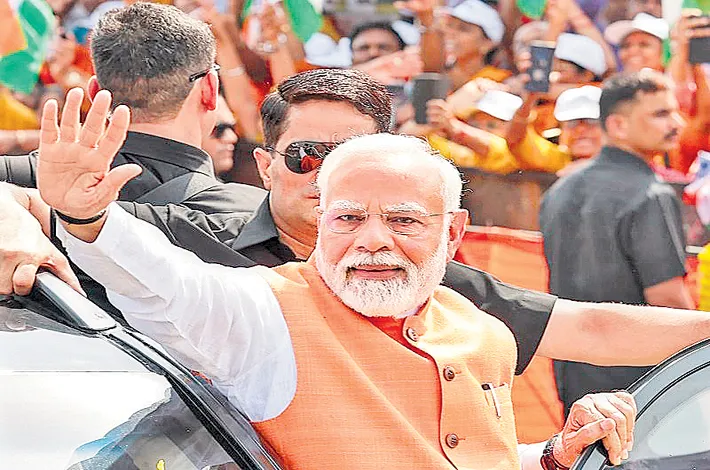Nature-based city: Unlearnt lesson of July 2005 floods
18-07-2025 12:00:00 AM

When the city’s natural water paths and flood barriers are being broken down by design, how will nature-based solutions help?
The end of July this year marks 20 long years since that horrid day and night when a large part of Mumbai, essentially the suburbs, were lashed by unrelenting rain and inundated with floods, which still gives people nightmares. The July 26th flood and the huge destruction of lives and property in its wake was a rude awakening for a city that had become used to taking every challenge in its stride and prided itself on its resilient spirit. It meant an assessment of what had come apart in those harrowing hours, forcing us all to take a long, hard look at the city-building itself.
It’s fair to ask if Mumbai, which has seen rain days with massive rainfall in several monsoons since, has learnt the lessons of that July day. Is it in any way better prepared and better equipped to handle extreme weather events of rain, heat or poor air? There is undoubtedly a greater level of awareness of these in Mumbaikars as well as the authorities. A few baby steps may have been taken to align the city’s systems with the demands that such extreme events make; there’s an acknowledgement of climate change impact.
At least, there’s much chatter in the corridors of power and in conference rooms of think tanks—of which there are many more now than in 2005 or at any time that I have seen in the past 35 years—about climate action plans, heat action plans, flood-proofing areas, blue-green infrastructure and so on. The term ‘blue-green infrastructure’ exemplifies so much that the city is not getting right; it is a dangerously reductive way to see natural areas, such as forests and water, in modern capitalist terms of ‘infrastructure’.
But whether it is the city’s rivers and water bodies that are so central to draining out rainwater or the city’s holistic natural ecology, of which the water bodies are an intrinsic part, Mumbai is in no better shape than it was that fateful day of July 2005.
While it is true that no urban area, especially large and dense cities like Mumbai, can take incessant rainfall of 944 mm in a day in their stride, it is equally true that Mumbai’s systems—both its constructed ones like the suburban railway network and the ever-congested roads and the natural ones like its forests and rivers—do not give the confidence that another extreme rain event, unprecedented in volume and character, would not leave the city in shambles.
One aspect has changed, though. Back in 2005, the international media rubbished Mumbai for what that rainfall event had done, pulling out the usual tropes of it being in a developing country, corrupt practices, general indiscipline and so forth. Twenty years later, after nearly every major city across Europe and the United States, including the mecca of the developed world, New York, this week itself, has been brought to its knees with intense rainfall and the resulting floods, the international lens has become less harsh on Mumbai and other Asian cities. New York and New Jersey were flooded out. NY received 53 mm of rain in an hour, the city’s third-wettest hour on record, according to reports.
This week, from parts of Botswana in southern Africa to cities in China and Nepal, devastating flash floods have been recorded everywhere. The global pattern is unmissable—climate change has altered weather patterns across the world. In coastal cities like Mumbai, sea levels are rising ever so slowly too. From mythological and Biblical references to moving people away from the high-risk zones to raising the ground level of structures to account for rising water, everyone is trying everything.
These are still engineering solutions, fixing the tap while the river is rushing, so to speak. What cities—certainly Mumbai—require is an unequivocal embrace of nature-based development. Not merely Nature-based Solutions, or NbS, which too have become the flavour of the season with governments and think tanks, but to approach the very act of city planning and city building through the lens of nature. This is, of course, easier said than accepted, let alone done.
The city is at a stage where no amount of tap-fixing tactics like water pumps in low-lying areas and raising floor levels can lead to sustainability if the wanton destruction of mangroves and forests (like the Aarey, which has seen thousands of trees hacked for various projects), reckless quarrying of hills (the Powai-Ghatkopar belt is nearly flat now), continued fragmentation of water bodies and massive concretisation goes on in the name of infrastructure and development. The Mithi River, the arch-villain of the 2005 floods, has not seen dramatic improvements over these decades; it has seen more construction in and around its floodplains. In fact, a Supreme Court-appointed committee of experts is needed to keep watch on its restoration.
Mumbai, as a number of studies have shown, is an estuary with rivers, wetlands, nallahs and many streams emptying out into the Arabian Sea. When its natural water paths and flood barriers, such as mangroves and wetlands, are being deliberately, by design, broken down, how nature-based solutions like vertical forests on buildings will help is anybody’s guess. Indeed, Mumbai needs better infrastructure, and its economy is closely tied to the development of land or redevelopment of buildings. But at what cost? As the Native American Cree philosophy reminds us: “Only when the last tree has been cut down, the last fish caught, and the last stream poisoned, will we realise we cannot eat money.”








